Animal Wound Care Market Insights 2025, Analysis and Forecast to 2030, by Manufacturers, Regions, Technology, Application, Product Type
- Single User License (1 Users) $ 3,200
- Team License (2~5 Users) $ 4,200
- Corporate License (>5 Users) $ 5,200
Introduction
Animal wound care products, including surgical, advanced, traditional wound care products, and therapy devices, are essential for managing injuries in companion animals and livestock. These products promote healing, prevent infections, and reduce pain, driven by the growing pet care industry, valued at USD 261 billion in 2022, and rising animal welfare concerns. Innovations like superabsorbent dressings and anti-biofilm technologies enhance efficacy. The global animal wound care market is projected to reach between USD 800 million and USD 1,300 million in 2025, with a compound annual growth rate (CAGR) of 5.5% to 9.3% through 2030.
Regional Analysis
North America: The U.S. leads due to high pet ownership and advanced veterinary care, with Canada focusing on livestock wound management.
Europe: Germany and the UK drive demand through strict animal welfare standards.
Asia Pacific: China and India see growth due to expanding pet markets, while Japan emphasizes advanced wound care.
Rest of the World: Brazil invests in livestock health, and Australia prioritizes companion animal care.
Application Analysis
Veterinary Hospitals/Clinics: Expected growth of 5.6%-9.4%, driven by surgical and trauma care. Trends focus on advanced dressings.
Homecare: Projected growth of 5.4%-9.2%, linked to pet owner involvement. Developments emphasize easy-to-use gels.
Research Institutes: Anticipated growth of 5.3%-9.1%, tied to veterinary studies. Advances prioritize therapy devices.
Type Analysis
Surgical Wound Care Products: Expected growth of 5.6%-9.4%, valued for post-operative care. Trends highlight absorbable sutures.
Advanced Wound Care Products: Projected growth of 5.7%-9.5%, driven by infection prevention. Innovations like CytaCoat’s anti-biofilm dressings lead.
Traditional Wound Care Products: Anticipated growth of 5.3%-9.1%, linked to cost-effectiveness. Trends focus on improved bandages.
Therapy Devices: Expected growth of 5.5%-9.3%, driven by wound healing acceleration. Advances prioritize laser therapy.
Key Market Players
3M offers advanced wound dressings.
Medtronic provides surgical wound solutions.
B. Braun specializes in veterinary wound care.
Johnson & Johnson delivers innovative dressings.
Advancis Veterinary focuses on antimicrobial solutions.
INNOVACYN emphasizes homecare products.
Virbac offers comprehensive wound care solutions.
Market News
In September 2024, CytaCoat AB and Absorbest AB partnered to develop superabsorbent wound care dressings with anti-biofilm properties for veterinary use, expected in 2025.
In August 2024, KeraVet Bio announced the May 2025 launch of KeraVet Gel for faster wound healing in pets.
In May 2024, epiq Animal Health partnered with KeraVet Bio to expand wound care product distribution.
In April 2024, Kane Biotech sold its STEM Animal Health stake to Dechra for CAD 11.5 million, focusing on wound care growth.
Porter’s Five Forces Analysis
Threat of New Entrants: Moderate, due to R&D costs and regulatory barriers, though generic products lower entry hurdles.
Threat of Substitutes: Low, as alternative treatments like herbal remedies are less effective.
Bargaining Power of Buyers: Moderate, with clinics seeking cost-effective solutions, but specialized products limit options.
Bargaining Power of Suppliers: Low, given multiple suppliers for medical materials.
Competitive Rivalry: High, with firms competing on innovation and efficacy.
Market Opportunities and Challenges
Opportunities:
The global pet care market, valued at USD 261 billion in 2022, and China’s USD 187 billion pet market in 2023 drive demand.
The WHO’s animal welfare focus increased animal care product demand by 10% in 2023.
An 8% rise in global veterinary clinics in 2023 supports wound management services.
Livestock wound care, growing 7% in 2023, boosts demand due to environmental injuries.
Innovations like anti-biofilm dressings improve outcomes.
Emerging markets in Asia offer growth potential.
Challenges:
High costs of advanced products limit adoption in developing regions.
Regulatory compliance delays market entry.
Limited awareness of advanced wound care in rural areas slows growth.
Competition from low-cost traditional products persists.
Supply chain disruptions affect material availability.
Chapter 1 Executive Summary
Chapter 2 Abbreviation and Acronyms
Chapter 3 Preface
3.1 Research Scope
3.2 Research Sources
3.2.1 Data Sources
3.2.2 Assumptions
3.3 Research Method
Chapter 4 Market Landscape
4.1 Market Overview
4.2 Classification/Types
4.3 Application/End Users
Chapter 5 Market Trend Analysis
5.1 Introduction
5.2 Drivers
5.3 Restraints
5.4 Opportunities
5.5 Threats
Chapter 6 Industry Chain Analysis
6.1 Upstream/Suppliers Analysis
6.2 Animal Wound Care Analysis
6.2.1 Technology Analysis
6.2.2 Cost Analysis
6.2.3 Market Channel Analysis
6.3 Downstream Buyers/End Users
Chapter 7 Latest Market Dynamics
7.1 Latest News
7.2 Merger and Acquisition
7.3 Planned/Future Project
7.4 Policy Dynamics
Chapter 8 Historical and Forecast Animal Wound Care Market in North America (2020-2030)
8.1 Animal Wound Care Market Size
8.2 Animal Wound Care Market by End Use
8.3 Competition by Players/Suppliers
8.4 Animal Wound Care Market Size by Type
8.5 Key Countries Analysis
8.5.1 United States
8.5.2 Canada
8.5.3 Mexico
Chapter 9 Historical and Forecast Animal Wound Care Market in South America (2020-2030)
9.1 Animal Wound Care Market Size
9.2 Animal Wound Care Market by End Use
9.3 Competition by Players/Suppliers
9.4 Animal Wound Care Market Size by Type
9.5 Key Countries Analysis
9.5.1 Brazil
9.5.2 Argentina
9.5.3 Chile
9.5.4 Peru
Chapter 10 Historical and Forecast Animal Wound Care Market in Asia & Pacific (2020-2030)
10.1 Animal Wound Care Market Size
10.2 Animal Wound Care Market by End Use
10.3 Competition by Players/Suppliers
10.4 Animal Wound Care Market Size by Type
10.5 Key Countries Analysis
10.5.1 China
10.5.2 India
10.5.3 Japan
10.5.4 South Korea
10.5.5 Southest Asia
10.5.6 Australia
Chapter 11 Historical and Forecast Animal Wound Care Market in Europe (2020-2030)
11.1 Animal Wound Care Market Size
11.2 Animal Wound Care Market by End Use
11.3 Competition by Players/Suppliers
11.4 Animal Wound Care Market Size by Type
11.5 Key Countries Analysis
11.5.1 Germany
11.5.2 France
11.5.3 United Kingdom
11.5.4 Italy
11.5.5 Spain
11.5.6 Belgium
11.5.7 Netherlands
11.5.8 Austria
11.5.9 Poland
11.5.10 Russia
Chapter 12 Historical and Forecast Animal Wound Care Market in MEA (2020-2030)
12.1 Animal Wound Care Market Size
12.2 Animal Wound Care Market by End Use
12.3 Competition by Players/Suppliers
12.4 Animal Wound Care Market Size by Type
12.5 Key Countries Analysis
12.5.1 Egypt
12.5.2 Israel
12.5.3 South Africa
12.5.4 Gulf Cooperation Council Countries
12.5.5 Turkey
Chapter 13 Summary For Global Animal Wound Care Market (2020-2025)
13.1 Animal Wound Care Market Size
13.2 Animal Wound Care Market by End Use
13.3 Competition by Players/Suppliers
13.4 Animal Wound Care Market Size by Type
Chapter 14 Global Animal Wound Care Market Forecast (2025-2030)
14.1 Animal Wound Care Market Size Forecast
14.2 Animal Wound Care Application Forecast
14.3 Competition by Players/Suppliers
14.4 Animal Wound Care Type Forecast
Chapter 15 Analysis of Global Key Vendors
15.1 3M
15.1.1 Company Profile
15.1.2 Main Business and Animal Wound Care Information
15.1.3 SWOT Analysis of 3M
15.1.4 3M Animal Wound Care Sales, Revenue, Price and Gross Margin (2020-2025)
15.2 Medtronic
15.2.1 Company Profile
15.2.2 Main Business and Animal Wound Care Information
15.2.3 SWOT Analysis of Medtronic
15.2.4 Medtronic Animal Wound Care Sales, Revenue, Price and Gross Margin (2020-2025)
15.3 B. Braun
15.3.1 Company Profile
15.3.2 Main Business and Animal Wound Care Information
15.3.3 SWOT Analysis of B. Braun
15.3.4 B. Braun Animal Wound Care Sales, Revenue, Price and Gross Margin (2020-2025)
15.4 Johnson & Johnson
15.4.1 Company Profile
15.4.2 Main Business and Animal Wound Care Information
15.4.3 SWOT Analysis of Johnson & Johnson
15.4.4 Johnson & Johnson Animal Wound Care Sales, Revenue, Price and Gross Margin (2020-2025)
15.5 Advancis Veterinary
15.5.1 Company Profile
15.5.2 Main Business and Animal Wound Care Information
15.5.3 SWOT Analysis of Advancis Veterinary
15.5.4 Advancis Veterinary Animal Wound Care Sales, Revenue, Price and Gross Margin (2020-2025)
15.6 INNOVACYN
15.6.1 Company Profile
15.6.2 Main Business and Animal Wound Care Information
15.6.3 SWOT Analysis of INNOVACYN
15.6.4 INNOVACYN Animal Wound Care Sales, Revenue, Price and Gross Margin (2020-2025)
Please ask for sample pages for full companies list
Table Research Scope Of Animal Wound Care Report
Table Data Sources Of Animal Wound Care Report
Table Major Assumptions Of Animal Wound Care Report
Table Animal Wound Care Classification
Table Animal Wound Care Applications
Table Drivers Of Animal Wound Care Market
Table Restraints Of Animal Wound Care Market
Table Opportunities Of Animal Wound Care Market
Table Threats Of Animal Wound Care Market
Table Raw Materials Suppliers
Table Different Production Methods Of Animal Wound Care
Table Cost Structure Analysis Of Animal Wound Care
Table Key End Users
Table Latest News Of Animal Wound Care Market
Table Merger And Acquisition
Table Planned/Future Project Of Animal Wound Care Market
Table Policy Of Animal Wound Care Market
Table 2020-2030 North America Animal Wound Care Market Size
Table 2020-2030 North America Animal Wound Care Market Size By Application
Table 2020-2025 North America Animal Wound Care Key Players Revenue
Table 2020-2025 North America Animal Wound Care Key Players Market Share
Table 2020-2030 North America Animal Wound Care Market Size By Type
Table 2020-2030 United States Animal Wound Care Market Size
Table 2020-2030 Canada Animal Wound Care Market Size
Table 2020-2030 Mexico Animal Wound Care Market Size
Table 2020-2030 South America Animal Wound Care Market Size
Table 2020-2030 South America Animal Wound Care Market Size By Application
Table 2020-2025 South America Animal Wound Care Key Players Revenue
Table 2020-2025 South America Animal Wound Care Key Players Market Share
Table 2020-2030 South America Animal Wound Care Market Size By Type
Table 2020-2030 Brazil Animal Wound Care Market Size
Table 2020-2030 Argentina Animal Wound Care Market Size
Table 2020-2030 Chile Animal Wound Care Market Size
Table 2020-2030 Peru Animal Wound Care Market Size
Table 2020-2030 Asia & Pacific Animal Wound Care Market Size
Table 2020-2030 Asia & Pacific Animal Wound Care Market Size By Application
Table 2020-2025 Asia & Pacific Animal Wound Care Key Players Revenue
Table 2020-2025 Asia & Pacific Animal Wound Care Key Players Market Share
Table 2020-2030 Asia & Pacific Animal Wound Care Market Size By Type
Table 2020-2030 China Animal Wound Care Market Size
Table 2020-2030 India Animal Wound Care Market Size
Table 2020-2030 Japan Animal Wound Care Market Size
Table 2020-2030 South Korea Animal Wound Care Market Size
Table 2020-2030 Southeast Asia Animal Wound Care Market Size
Table 2020-2030 Australia Animal Wound Care Market Size
Table 2020-2030 Europe Animal Wound Care Market Size
Table 2020-2030 Europe Animal Wound Care Market Size By Application
Table 2020-2025 Europe Animal Wound Care Key Players Revenue
Table 2020-2025 Europe Animal Wound Care Key Players Market Share
Table 2020-2030 Europe Animal Wound Care Market Size By Type
Table 2020-2030 Germany Animal Wound Care Market Size
Table 2020-2030 France Animal Wound Care Market Size
Table 2020-2030 United Kingdom Animal Wound Care Market Size
Table 2020-2030 Italy Animal Wound Care Market Size
Table 2020-2030 Spain Animal Wound Care Market Size
Table 2020-2030 Belgium Animal Wound Care Market Size
Table 2020-2030 Netherlands Animal Wound Care Market Size
Table 2020-2030 Austria Animal Wound Care Market Size
Table 2020-2030 Poland Animal Wound Care Market Size
Table 2020-2030 Russia Animal Wound Care Market Size
Table 2020-2030 Mea Animal Wound Care Market Size
Table 2020-2030 Mea Animal Wound Care Market Size By Application
Table 2020-2025 Mea Animal Wound Care Key Players Revenue
Table 2020-2025 Mea Animal Wound Care Key Players Market Share
Table 2020-2030 Mea Animal Wound Care Market Size By Type
Table 2020-2030 Egypt Animal Wound Care Market Size
Table 2020-2030 Israel Animal Wound Care Market Size
Table 2020-2030 South Africa Animal Wound Care Market Size
Table 2020-2030 Gulf Cooperation Council Countries Animal Wound Care Market Size
Table 2020-2030 Turkey Animal Wound Care Market Size
Table 2020-2025 Global Animal Wound Care Market Size By Region
Table 2020-2025 Global Animal Wound Care Market Size Share By Region
Table 2020-2025 Global Animal Wound Care Market Size By Application
Table 2020-2025 Global Animal Wound Care Market Share By Application
Table 2020-2025 Global Animal Wound Care Key Vendors Revenue
Table 2020-2025 Global Animal Wound Care Key Vendors Market Share
Table 2020-2025 Global Animal Wound Care Market Size By Type
Table 2020-2025 Global Animal Wound Care Market Share By Type
Table 2025-2030 Global Animal Wound Care Market Size By Region
Table 2025-2030 Global Animal Wound Care Market Size Share By Region
Table 2025-2030 Global Animal Wound Care Market Size By Application
Table 2025-2030 Global Animal Wound Care Market Share By Application
Table 2025-2030 Global Animal Wound Care Key Vendors Revenue
Table 2025-2030 Global Animal Wound Care Key Vendors Market Share
Table 2025-2030 Global Animal Wound Care Market Size By Type
Table 2025-2030 Animal Wound Care Global Market Share By Type
Figure Market Size Estimated Method
Figure Major Forecasting Factors
Figure Animal Wound Care Picture
Figure 2020-2030 North America Animal Wound Care Market Size And Cagr
Figure 2020-2030 South America Animal Wound Care Market Size And Cagr
Figure 2020-2030 Asia & Pacific Animal Wound Care Market Size And Cagr
Figure 2020-2030 Europe Animal Wound Care Market Size And Cagr
Figure 2020-2030 Mea Animal Wound Care Market Size And Cagr
Figure 2020-2025 Global Animal Wound Care Market Size And Growth Rate
Figure 2025-2030 Global Animal Wound Care Market Size And Growth Rate
Research Methodology
- Market Estimated Methodology:
Bottom-up & top-down approach, supply & demand approach are the most important method which is used by HDIN Research to estimate the market size.
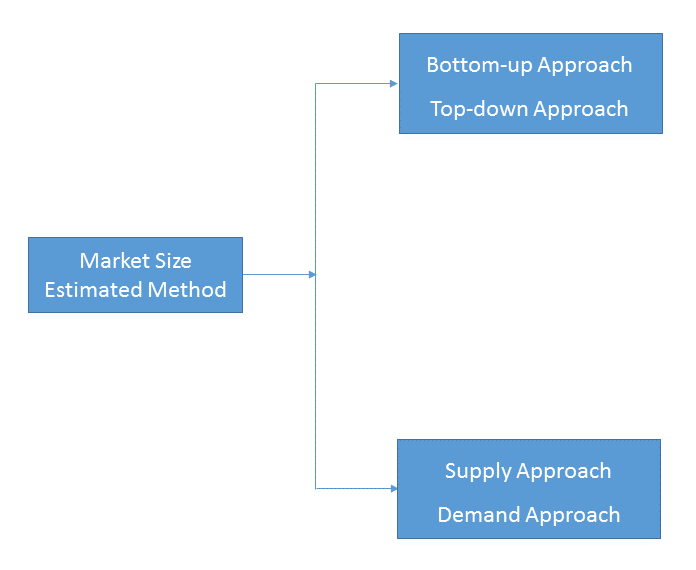
1)Top-down & Bottom-up Approach
Top-down approach uses a general market size figure and determines the percentage that the objective market represents.
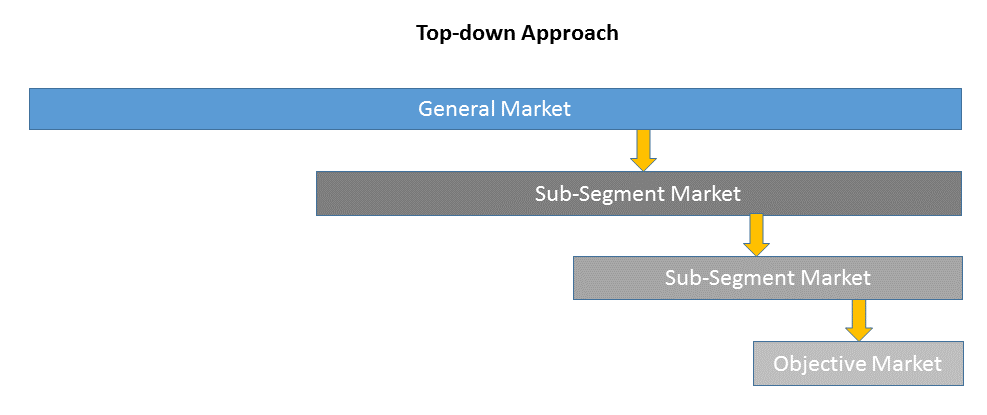
Bottom-up approach size the objective market by collecting the sub-segment information.

2)Supply & Demand Approach
Supply approach is based on assessments of the size of each competitor supplying the objective market.
Demand approach combine end-user data within a market to estimate the objective market size. It is sometimes referred to as bottom-up approach.
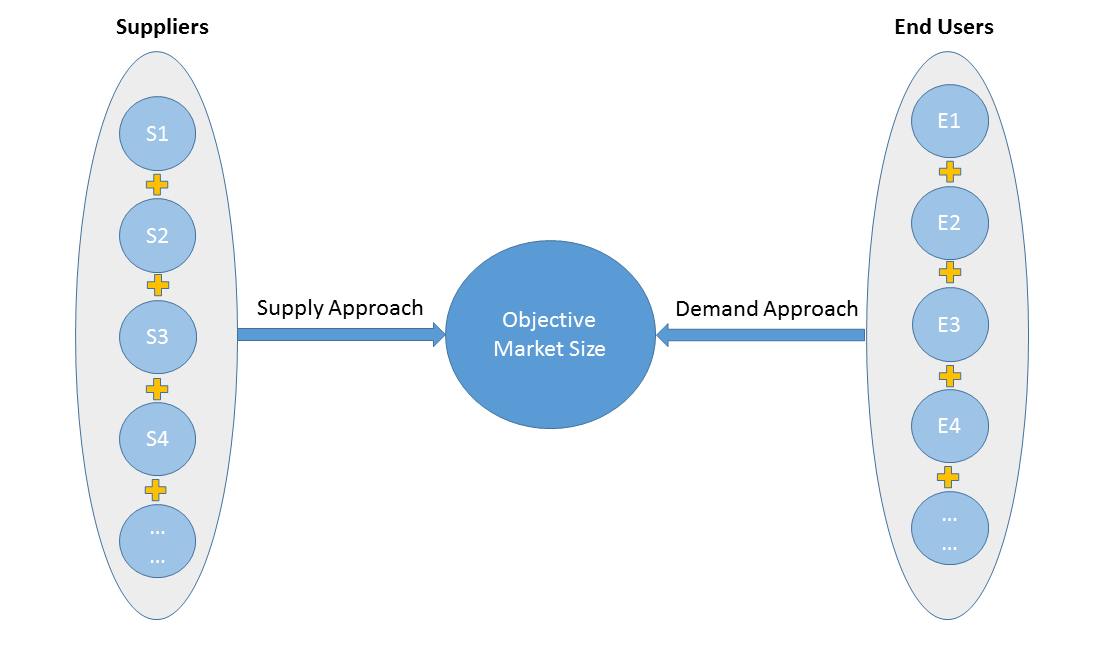
- Forecasting Methodology
- Numerous factors impacting the market trend are considered for forecast model:
- New technology and application in the future;
- New project planned/under contraction;
- Global and regional underlying economic growth;
- Threatens of substitute products;
- Industry expert opinion;
- Policy and Society implication.
- Analysis Tools
1)PEST Analysis
PEST Analysis is a simple and widely used tool that helps our client analyze the Political, Economic, Socio-Cultural, and Technological changes in their business environment.
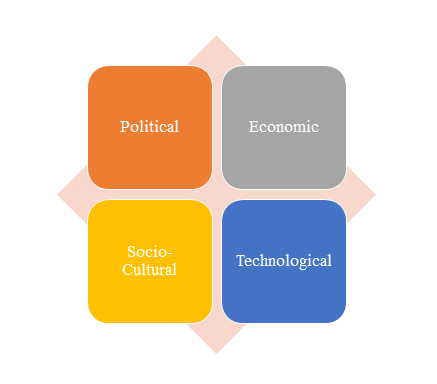
- Benefits of a PEST analysis:
- It helps you to spot business opportunities, and it gives you advanced warning of significant threats.
- It reveals the direction of change within your business environment. This helps you shape what you’re doing, so that you work with change, rather than against it.
- It helps you avoid starting projects that are likely to fail, for reasons beyond your control.
- It can help you break free of unconscious assumptions when you enter a new country, region, or market; because it helps you develop an objective view of this new environment.
2)Porter’s Five Force Model Analysis
The Porter’s Five Force Model is a tool that can be used to analyze the opportunities and overall competitive advantage. The five forces that can assist in determining the competitive intensity and potential attractiveness within a specific area.
- Threat of New Entrants: Profitable industries that yield high returns will attract new firms.
- Threat of Substitutes: A substitute product uses a different technology to try to solve the same economic need.
- Bargaining Power of Customers: the ability of customers to put the firm under pressure, which also affects the customer's sensitivity to price changes.
- Bargaining Power of Suppliers: Suppliers of raw materials, components, labor, and services (such as expertise) to the firm can be a source of power over the firm when there are few substitutes.
- Competitive Rivalry: For most industries the intensity of competitive rivalry is the major determinant of the competitiveness of the industry.
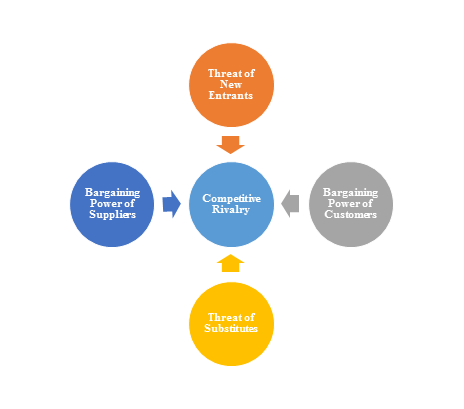
3)Value Chain Analysis
Value chain analysis is a tool to identify activities, within and around the firm and relating these activities to an assessment of competitive strength. Value chain can be analyzed by primary activities and supportive activities. Primary activities include: inbound logistics, operations, outbound logistics, marketing & sales, service. Support activities include: technology development, human resource management, management, finance, legal, planning.
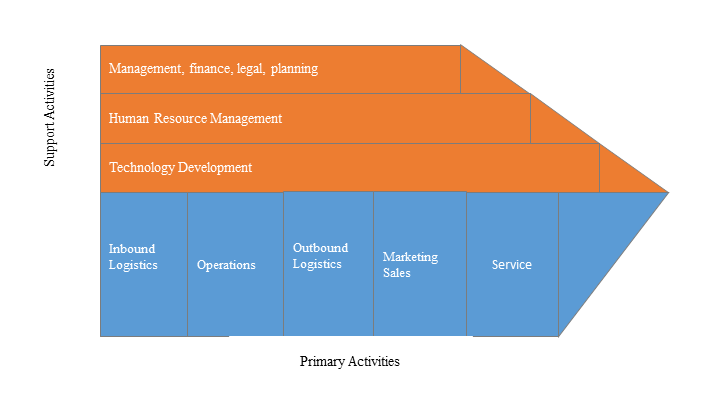
4)SWOT Analysis
SWOT analysis is a tool used to evaluate a company's competitive position by identifying its strengths, weaknesses, opportunities and threats. The strengths and weakness is the inner factor; the opportunities and threats are the external factor. By analyzing the inner and external factors, the analysis can provide the detail information of the position of a player and the characteristics of the industry.
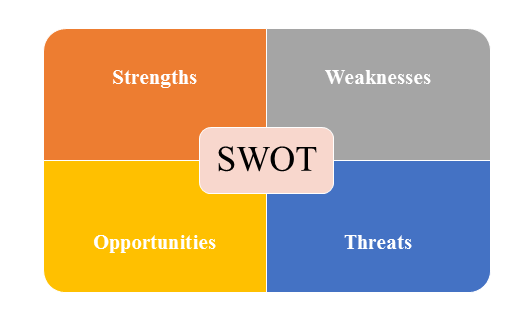
- Strengths describe what the player excels at and separates it from the competition
- Weaknesses stop the player from performing at its optimum level.
- Opportunities refer to favorable external factors that the player can use to give it a competitive advantage.
- Threats refer to factors that have the potential to harm the player.
- Data Sources
| Primary Sources | Secondary Sources |
|---|---|
| Face to face/Phone Interviews with market participants, such as: Manufactures; Distributors; End-users; Experts. Online Survey |
Government/International Organization Data: Annual Report/Presentation/Fact Book Internet Source Information Industry Association Data Free/Purchased Database Market Research Report Book/Journal/News |